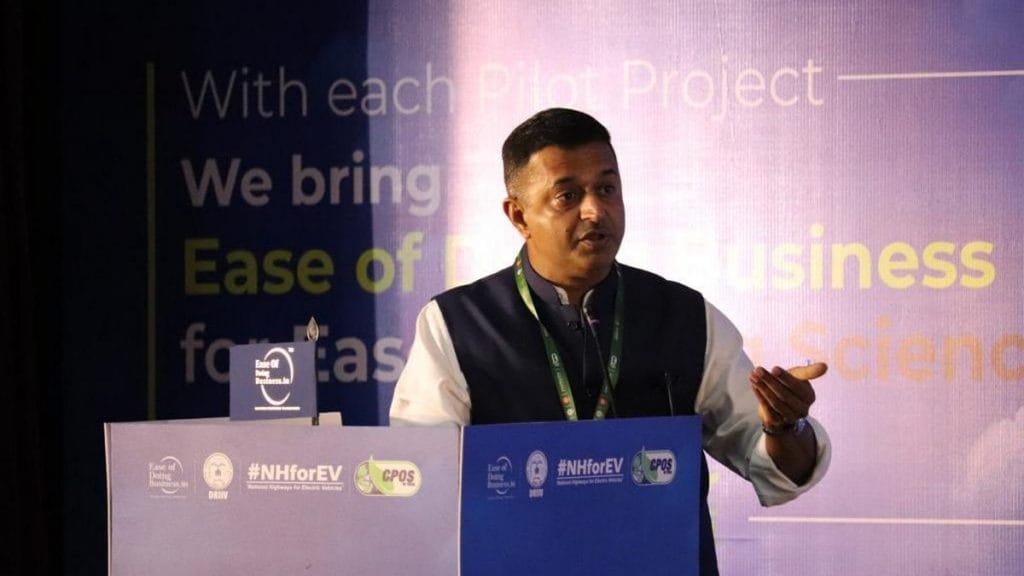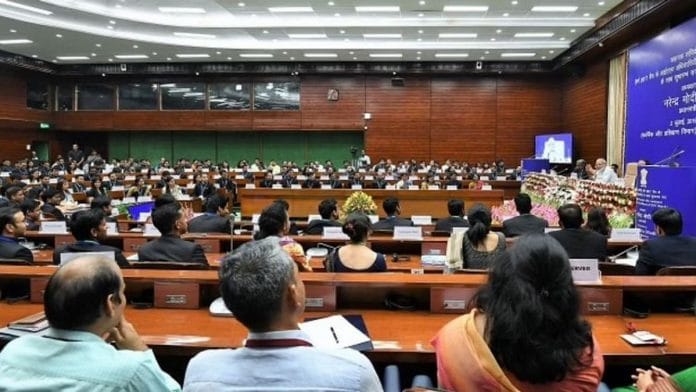New Delhi: Seven ‘lateral entrants’ who were inducted as joint secretaries in central government ministries in 2019 are set to have their tenures extended by two years, ThePrint has learnt.
“The government seems to be happy with them,” said Surendra Nath Tripathi, director-general of the Indian Institute of Public Administration (IIPA), which trains lateral entrants before they join their ministries. “One of the primary objectives was to hire expertise from the market and place them in relevant ministries. That purpose has been served,” he said.
ThePrint spoke to some of these lateral entrants, who confirmed that while they are yet to get the papers, the process for their extension has been initiated.
So far, a total of 37 officers appointed through lateral recruitment are serving in the bureaucracy at different levels, with seven selected in 2019 and 30 in 2021. The lateral entrants were required to sign a three-year contract, which was extendable by two years, contingent on their performance.
The performance review for the seven joint secretaries is still pending, Tripathi said.
“The government may initiate an overall performance review process for the lateral entrants, but, as of now, no one from the first batch has been sent back to the institute for training,” Tripathi said. “To my knowledge, only one person has left the government, the rest of them are working fine.”
A senior IAS officer at the Department of Personnel and Training (DoPT) added: “The respective ministries have designed an annual appraisal system for the laterals, and based on their performances, they have been rated.”
However, the Modi government’s plans to reform the civil services by bringing in specialists through the lateral entry process is unlikely to do much to solve the shortage of IAS officers at the Centre.
The DoPT officer told ThePrint that while the government will continue to hire laterals as experts for technical and specialised fields, they will not be inducted in core administrative ministries, like DoPT or Home. “The scheme for lateral entry will also be reviewed soon,” he added.
In a written reply in Parliament on 28 June, DoPT Minister of State Jitendra Singh said that the government has decided to place lateral entrants in ministries and departments that need to work in tandem with the private sector, like civil aviation, economic affairs, environment, forest and climate change, financial services, and renewable energy.
The 37 serving lateral entrants are in positions across 21 ministries and departments at the ranks of joint secretary, director, and deputy secretary. Among these, 10 are joint secretaries (seven hired in 2019 and three in 2021), with four among them on deputation from state services or the public sector, and six from corporate sectors.
Also read: How did Pakistan’s “IAS” deal with lateral entry? Lessons for Modi’s India
‘We knew what we were getting into’
In 2019, a total of nine lateral entrants were selected to work as joint secretaries, out of which seven are currently serving — Amber Dubey, Rajeev Saksena, Sujit Kumar Bajpayee, Dinesh Dayanand Jagdale, Bhushan Kumar, Saurabh Mishra, and Suman Prasad Singh. In December 2020, Arun Goel resigned to return to the private sector, while Kakoli Ghosh never joined the government despite making the cut.
The three joint secretaries from the 2021 batch of lateral entrants are Samuel Praveen Kumar, who is on deputation, and Balasubramanian Krishnamurthy and Manish Chadha who are on a three-year contract.
Speaking to The Print, Amber Dubey, joint secretary, Ministry of Civil Aviation, said that he experienced the “usual hiccups” with other officials but since he was “amply forewarned”, he was able to take it in his stride.

“One has to just soldier on, since the mission objectives are far bigger than the roadblocks on the way. Further, critics, doubters, and naysayers — and I have met plenty over the last three years — are a blessing in disguise. They keep us on our toes and make us sharper, better, and more determined,” Dubey, an IIT Bombay alum and former head of aerospace and defence at the business advisory firm KPMG India, said.
He did, however, acknowledge that there was an “extreme” focus on paperwork and process in government.
“A lot of that is time-consuming and unproductive, and even regular government officers complain about it. Gradually the scene is changing and the focus among most ministries is shifting to outputs and outcomes. That’s a welcome sign,” Dubey said.
After e-commerce professional Arun Goel, who joined as joint secretary, commerce, quit the service in 2020, there were reports of “bureaucratic tangles” leading to his resignation. ThePrint contacted Goel, but he refused to comment on the issue.
When asked about the aforementioned tangles, Dubey said that bureaucratic complications in government decision-making were common worldwide.
“We knew what we were getting into, so I have no complaints. One has to keep one’s head down, seek advice from seniors and peers, focus on the task at hand, and ignore the frustrations that come along the way. In most cases, things work out miraculously,” he said.
Another lateral entrant from another ministry, however, said on condition of anonymity that there wasn’t “enough freedom” to contribute to policymaking or take decisions.
Dubey, though, said that his experiences were different and he felt “lucky” that he was able to contribute to various policies, including the Drone Rules, 2021.
“I received significant freedom, guidance and encouragement from seniors and peers, cutting across ministries,” he said.
‘Market experts’, but no substitute for IAS
In a written reply in Parliament last year, Minister of State Jitendra Singh emphasised that the government had undertaken lateral recruitment with the “twin objectives of bringing fresh talent and augmenting the manpower at certain levels in the central government”.
However, the latter objective seems to have been struck off for now.
A member of the DoPT committee formed earlier this year to address the crunch in the number of central IAS officers has ruled out lateral hiring as a solution.
The panel, he said, has recommended that the government should use lateral entrants as “market experts” rather than as administrators dealing with governance and policymaking.
A second senior IAS officer in the DoPT added that the placement of lateral entrants has been strictly limited to ministries dealing with national or international markets and related affairs. He added that lateral entrants were not being placed in core administrative departments like the DoPT, and nor with those that deal with state governments, like the Ministry of Home Affairs.
Jitendra Singh also said in Parliament last month that there is no plan of posting lateral entrants to constitutional bodies, as these are administrative positions reserved for IAS officers.
Why not lateral entrants?
Senior IAS officers feel that the government cannot solve the crunch of IAS officers through lateral entry because these recruits, especially those from the private sector, are unlikely to have the training required to handle matters pertaining to federal functioning and to deal with state- and district-level officers.
“The lateral entrants, who are posted as joint secretaries, they have brought some of the latest skills from the private sectors, but running a country or a state needs a lot of administrative skills,” said Sanjeev Chopra, an IAS officer who retired as the director of the Lal Bahadur Shastri National Academy of Administration (LBSNAA).
He added: “There is a chain of command in service — it includes many administrative, logistical, and several other related issues. A civil service officer, working in the central government, needs a lot of coordination all the time, across departments and ministries, with states and districts.”
In their current appointments, joint secretary-level lateral entrants are not required to be in routine touch with their state counterparts, he added.
Another senior IAS officer, who retired as chief secretary recently, made a similar point.
“I believe, for technical matters, which are highly specialised, the government may hire lateral entrants. But the difficult part is to get them amalgamated into a regimented set-up like the Indian bureaucracy,” he said.
The senior officer added: “A joint secretary-level officer earns experience through 15 years of his service. A 15-day foundation course cannot replace that experience for the lateral entrants.”
(Edited by Asavari Singh)
Also read: CBI officer doesn’t need to be ‘cop’ anymore: Non-IPS induction raises ‘lateral entry’ question






